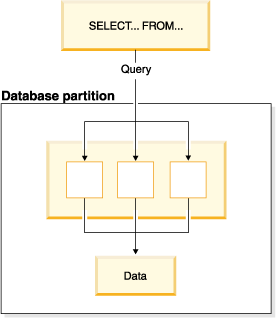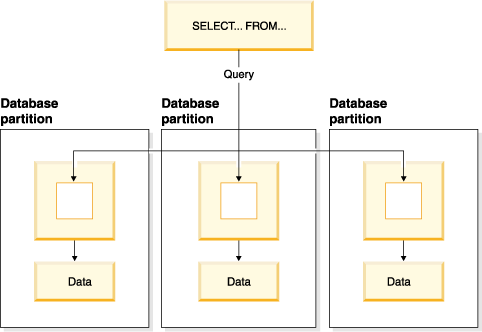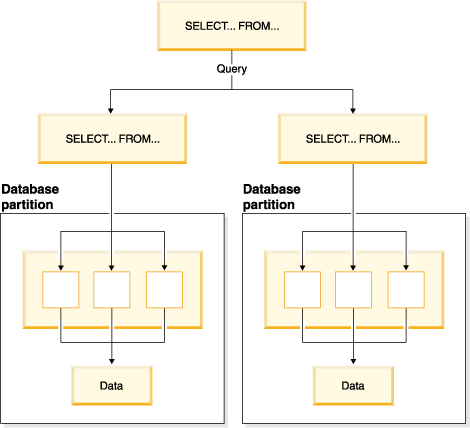Parallelism
Components of a task, such as a database query, can be run in parallel to dramatically enhance performance. The nature of the task, the database configuration, and the hardware environment, all determine how the Db2® database product will perform a task in parallel.
- I/O
- Query
- Utility
Input/output parallelism
When there are multiple containers for a table space, the database manager can use parallel I/O. Parallel I/O refers to the process of writing to, or reading from, two or more I/O devices simultaneously; it can result in significant improvements in throughput.
Query parallelism
There are two types of query parallelism: interquery parallelism and intraquery parallelism.
Interquery parallelism refers to the ability of the database to accept queries from multiple applications at the same time. Each query runs independently of the others, but the database manager runs all of them at the same time. Db2 database products have always supported this type of parallelism.
Intraquery parallelism refers to the simultaneous processing of parts of a single query, using either intrapartition parallelism, interpartition parallelism, or both.
Intrapartition parallelism
Intrapartition parallelism refers to the ability to break up a query into multiple parts. Some Db2 utilities also perform this type of parallelism.
Intrapartition parallelism subdivides what is typically considered to be a single database operation such as index creation, database loading, or SQL queries into multiple parts, many or all of which can be run in parallel within a single database partition.
Figure 1 shows a query that is broken into three pieces that can be run in parallel, with the results returned more quickly than if the query were run in serial fashion. The pieces are copies of each other. To use intrapartition parallelism, you must configure the database appropriately. You can choose the degree of parallelism or let the system do it for you. The degree of parallelism represents the number of pieces of a query running in parallel.

Interpartition parallelism
Interpartition parallelism refers to the ability to break up a query into multiple parts across multiple partitions of a partitioned database, on one machine or multiple machines. The query is run in parallel. Some Db2 utilities also perform this type of parallelism.
Interpartition parallelism subdivides what is typically considered a single database operation such as index creation, database loading, or SQL queries into multiple parts, many or all of which can be run in parallel across multiple partitions of a partitioned database on one machine or on multiple machines.
Figure 2 shows a query that is broken into three pieces that can be run in parallel, with the results returned more quickly than if the query were run in serial fashion on a single database partition.
The degree of parallelism is largely determined by the number of database partitions you create and how you define your database partition groups.

Simultaneous intrapartition and interpartition parallelism
You can use intrapartition parallelism and interpartition parallelism at the same time. This combination provides two dimensions of parallelism, resulting in an even more dramatic increase in the speed at which queries are processed.

Utility parallelism
Db2 utilities can take advantage of intrapartition parallelism. They can also take advantage of interpartition parallelism; where multiple database partitions exist, the utilities run in each of the database partitions in parallel.
The load utility can take advantage of intrapartition parallelism and I/O parallelism. Loading data is a CPU-intensive task. The load utility takes advantage of multiple processors for tasks such as parsing and formatting data. It can also use parallel I/O servers to write the data to containers in parallel.
In a partitioned database environment, the LOAD command takes advantage of intrapartition, interpartition, and I/O parallelism by parallel invocations at each database partition where the table resides.
During index creation, the scanning and subsequent sorting of the data occurs in parallel. The Db2 system exploits both I/O parallelism and intrapartition parallelism when creating an index. This helps to speed up index creation when a CREATE INDEX statement is issued, during restart (if an index is marked invalid), and during the reorganization of data.
Backing up and restoring data are heavily I/O-bound tasks. The Db2 system exploits both I/O parallelism and intrapartition parallelism when performing backup and restore operations. Backup exploits I/O parallelism by reading from multiple table space containers in parallel, and asynchronously writing to multiple backup media in parallel.